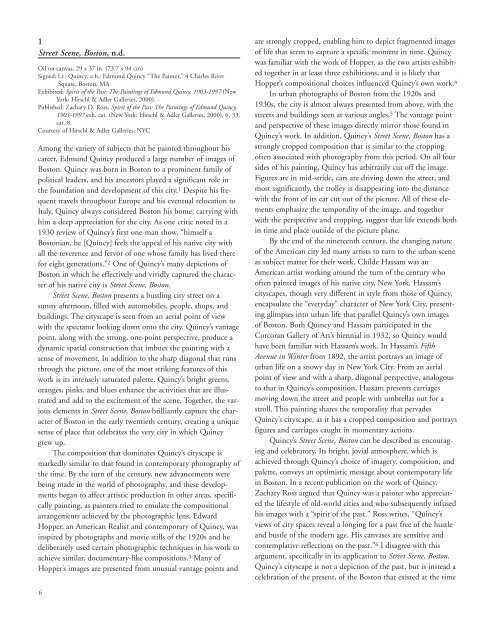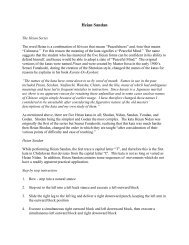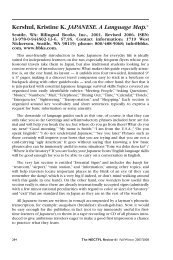selected paintings - Dickinson College
selected paintings - Dickinson College
selected paintings - Dickinson College
You also want an ePaper? Increase the reach of your titles
YUMPU automatically turns print PDFs into web optimized ePapers that Google loves.
1<br />
Street Scene, Boston, n.d.<br />
Oil on canvas, 29 x 37 in. (73.7 x 94 cm)<br />
Signed: l.r.: Quincy; c.b.: Edmund Quincy “The Painter,” 4 Charles River<br />
Square, Boston, MA<br />
Exhibited: Spirit of the Past: The Paintings of Edmund Quincy, 1903-1997 (New<br />
York: Hirschl & Adler Galleries, 2000).<br />
Published: Zachary D. Ross, Spirit of the Past: The Paintings of Edmund Quincy,<br />
1903-1997 exh. cat. (New York: Hirschl & Adler Galleries, 2000), 6, 33,<br />
cat. 8.<br />
Courtesy of Hirschl & Adler Galleries, NYC<br />
Among the variety of subjects that he painted throughout his<br />
career, Edmund Quincy produced a large number of images of<br />
Boston. Quincy was born in Boston to a prominent family of<br />
political leaders, and his ancestors played a significant role in<br />
the foundation and development of this city. 1 Despite his frequent<br />
travels throughout Europe and his eventual relocation to<br />
Italy, Quincy always considered Boston his home, carrying with<br />
him a deep appreciation for the city. As one critic noted in a<br />
1930 review of Quincy’s first one-man show, “himself a<br />
Bostonian, he [Quincy] feels the appeal of his native city with<br />
all the reverence and fervor of one whose family has lived there<br />
for eight generations.” 2 One of Quincy’s many depictions of<br />
Boston in which he effectively and vividly captured the character<br />
of his native city is Street Scene, Boston.<br />
Street Scene, Boston presents a bustling city street on a<br />
sunny afternoon, filled with automobiles, people, shops, and<br />
buildings. The cityscape is seen from an aerial point of view<br />
with the spectator looking down onto the city. Quincy’s vantage<br />
point, along with the strong, one-point perspective, produce a<br />
dynamic spatial construction that imbues the painting with a<br />
sense of movement. In addition to the sharp diagonal that runs<br />
through the picture, one of the most striking features of this<br />
work is its intensely saturated palette. Quincy’s bright greens,<br />
oranges, pinks, and blues enhance the activities that are illustrated<br />
and add to the excitement of the scene. Together, the various<br />
elements in Street Scene, Boston brilliantly capture the character<br />
of Boston in the early twentieth century, creating a unique<br />
sense of place that celebrates the very city in which Quincy<br />
grew up.<br />
The composition that dominates Quincy’s cityscape is<br />
markedly similar to that found in contemporary photography of<br />
the time. By the turn of the century, new advancements were<br />
being made in the world of photography, and these developments<br />
began to affect artistic production in other areas, specifically<br />
painting, as painters tried to emulate the compositional<br />
arrangements achieved by the photographic lens. Edward<br />
Hopper, an American Realist and contemporary of Quincy, was<br />
inspired by photographs and movie stills of the 1920s and he<br />
deliberately used certain photographic techniques in his work to<br />
achieve similar, documentary-like compositions. 3 Many of<br />
Hopper’s images are presented from unusual vantage points and<br />
6<br />
are strongly cropped, enabling him to depict fragmented images<br />
of life that seem to capture a specific moment in time. Quincy<br />
was familiar with the work of Hopper, as the two artists exhibited<br />
together in at least three exhibitions, and it is likely that<br />
Hopper’s compositional choices influenced Quincy’s own work. 4<br />
In urban photographs of Boston from the 1920s and<br />
1930s, the city is almost always presented from above, with the<br />
streets and buildings seen at various angles. 5 The vantage point<br />
and perspective of these images directly mirror those found in<br />
Quincy’s work. In addition, Quincy’s Street Scene, Boston has a<br />
strongly cropped composition that is similar to the cropping<br />
often associated with photography from this period. On all four<br />
sides of his painting, Quincy has arbitrarily cut off the image.<br />
Figures are in mid-stride, cars are driving down the street, and<br />
most significantly, the trolley is disappearing into the distance<br />
with the front of its car cut out of the picture. All of these elements<br />
emphasize the temporality of the image, and together<br />
with the perspective and cropping, suggest that life extends both<br />
in time and place outside of the picture plane.<br />
By the end of the nineteenth century, the changing nature<br />
of the American city led many artists to turn to the urban scene<br />
as subject matter for their work. Childe Hassam was an<br />
American artist working around the turn of the century who<br />
often painted images of his native city, New York. Hassam’s<br />
cityscapes, though very different in style from those of Quincy,<br />
encapsulate the “everyday” character of New York City, presenting<br />
glimpses into urban life that parallel Quincy’s own images<br />
of Boston. Both Quincy and Hassam participated in the<br />
Corcoran Gallery of Art’s biennial in 1932, so Quincy would<br />
have been familiar with Hassam’s work. In Hassam’s Fifth<br />
Avenue in Winter from 1892, the artist portrays an image of<br />
urban life on a snowy day in New York City. From an aerial<br />
point of view and with a sharp, diagonal perspective, analogous<br />
to that in Quincy’s composition, Hassam presents carriages<br />
moving down the street and people with umbrellas out for a<br />
stroll. This painting shares the temporality that pervades<br />
Quincy’s cityscape, as it has a cropped composition and portrays<br />
figures and carriages caught in momentary actions.<br />
Quincy’s Street Scene, Boston can be described as encouraging<br />
and celebratory. Its bright, jovial atmosphere, which is<br />
achieved through Quincy’s choice of imagery, composition, and<br />
palette, conveys an optimistic message about contemporary life<br />
in Boston. In a recent publication on the work of Quincy,<br />
Zachary Ross argued that Quincy was a painter who appreciated<br />
the lifestyle of old-world cities and who subsequently infused<br />
his images with a “spirit of the past.” Ross writes, “Quincy’s<br />
views of city spaces reveal a longing for a past free of the hustle<br />
and bustle of the modern age. His canvases are sensitive and<br />
contemplative reflections on the past.” 6 I disagree with this<br />
argument, specifically in its application to Street Scene, Boston.<br />
Quincy’s cityscape is not a depiction of the past, but is instead a<br />
celebration of the present, of the Boston that existed at the time






